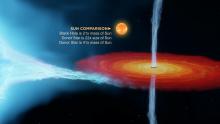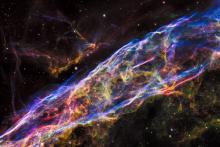Listen to today's episode of StarDate on the web the same day it airs in high-quality streaming audio without any extra ads or announcements. Choose a $8 one-month pass, or listen every day for a year for just $30.
You are here
Deneb
The Sun is pretty big as stars go — bigger than perhaps 80 or 90 percent of the stars in the entire Milky Way Galaxy. To get an idea of just how big, consider this: At the speed of a jet airliner, it would take about seven months to circle all the way around the Sun’s equator.
But if you really want to rack up the frequent-flier miles, try circling around the star at the tail of Cygnus, the swan.
Deneb is a white supergiant. The “white” designation means that its surface is thousands of degrees hotter than the Sun’s. And the “supergiant” designation means that it’s one of the biggest stars in the galaxy. In fact, it could be 200 times the diameter of the Sun. So even at the pace of a typical airliner, it would take more than a century to circle Deneb’s equator.
One problem you might have is deciding just where the star’s “surface” is. Supergiants are so puffed up that their outermost layers of gas are quite thin. And Deneb is blowing a powerful “wind” of material out into space, which makes it even harder to tell where the star ends and space begins.
But from our distance of 2600 light-years or so, that’s not a problem — Deneb looks like a sharp little point of light. It’s in the northeast at nightfall, at the left point of the bright Summer Triangle. And the rest of the swan stretches to its right, with the body roughly parallel to the horizon and the wings spread above and below.
Tomorrow: An ancient stellar family.
Script by Damond Benningfield






